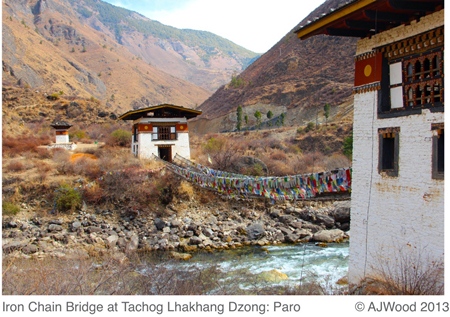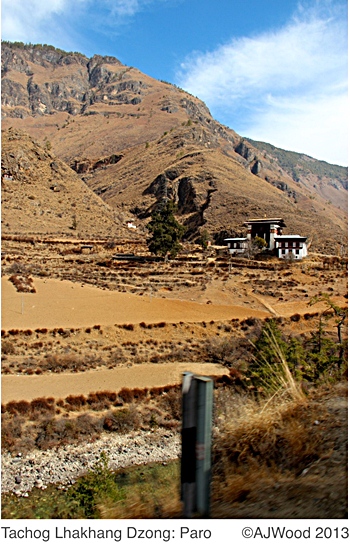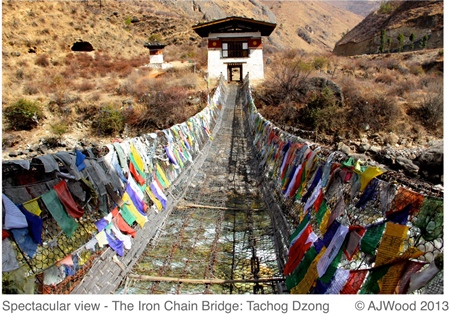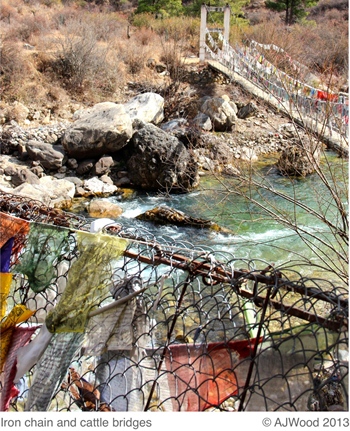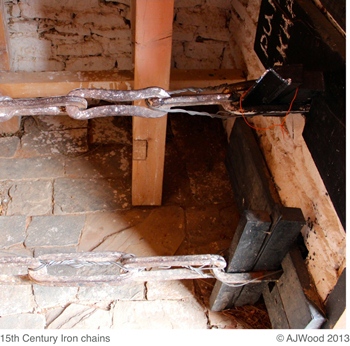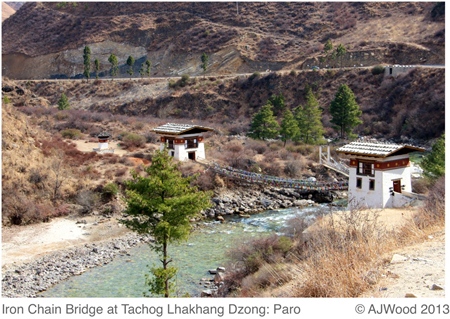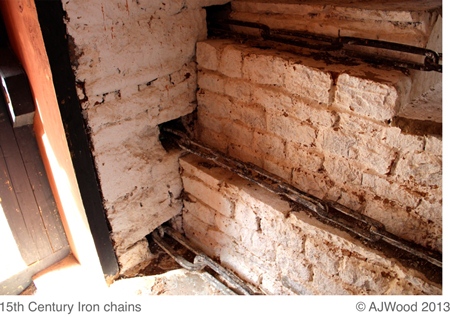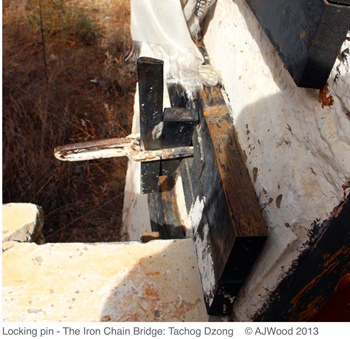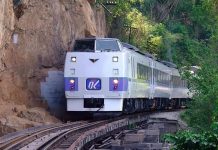Thangtong Gyalpo
Thangtong Gyalpo (1385-1464) was a great Buddhist, a yogi, physician, blacksmith, architect, and a pioneering civil engineer. He is said to have built many iron chain suspension bridges around Tibet and Bhutan, several of which are still in use today.
In Tibetan, Chakzampa means Bridge-Builder, and is one of the many names attributed to the famous Tibetan saint known as Thangtong Gyalpo, who lived in the 14th century in Tibet and later in Bhutan.

He is considered to be a patron saint of Tibetan medicine, as well as the founding father of Ache Lhamo, Tibetan opera. Legend has it that Thangtong Gyalpo recruited villagers to perform opera to help fund and build suspension bridges over the wide Himalayan rivers to allow access by pilgrims to the sacred Buddhist sites.
Tachog Lhakhang
Tachog Lhakhang Dzong is located in the Paro valley and was our first stop from Paro airport as we drove to the capital Thimphu on our 8-day visit to the Land of the Thunder Dragon.
Perched on the hillside over looking the River Paro Chhu stands the fortress Tachog Lhakhang Dzong and one must actually cross one of Drupthob Thangtong Gyalpo’s bridges to get to the Dzong. Drupthob Thangtong Gyalpo was the man who built the iron chain bridges in Bhutan in the 1400s, and is said to have built 108 of these bridges around Tibet and Bhutan. Many of them are still in use today, showing how strong and durable the bridges are. The Tachog Lhakhang Dzong itself is private, but can still be entered by visitors if permission is given. The Dzong is relatively small and has many fruit trees, orange and apple. The people who take care of the Dzong also herd cattle.
Bhutan
In 1433, Thangtong Gyalpo came to Bhutan. His route can be traced exactly. In Bhutan, the spiritual guru not only found open ears for his teachings, but he also found big iron ore deposits. The land was even more dependent on consolidated bridges than Tibet, as raft or ferry connections were not possible because of precipitous gorges and torrential rivers, except in some southern and eastern parts of the land.
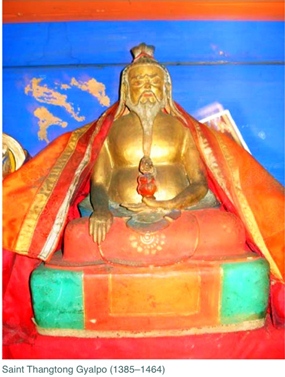
It is therefore no surprise that Thangtong Gyalpo immediately put into practise the vision that he had received, namely to make it easier for people to cross rivers and gorges with the construction of iron chain bridges. While travelling through Western Bhutan he visited places where he also found iron ore; for example Tachog (also called Damchog, Damchhu, Tashog or Tamtscho), or places that were associated with blacksmiths; for example Chang Dunkhar – above Paro airport. It is reported in the ‘History of Bhutan’ that in Paro, 18 blacksmiths went to the saint to help him and forge iron and more chain links.
The iron chain bridge at Tachog Lhakhan is festooned with brightly coloured prayer flags, like so many in Bhutan, with metal netting for extra support, it is quite flexible and acts a lot like a trampoline.
Looking down you can clearly see the chains and the river below, flowing with gusto, clear and ice cold. Staying dry depends on the 600 year old chains!
There is a separate bridge next to this one that is specifically for cattle to use, as crossing over an iron chain bridge is very difficult and dangerous for them.
Dupthob Thangtong Gyalpo is believed to be the first to use heavy iron chains to construct suspension bridges. As mentioned earlier he built 108 bridges in Tibet and Bhutan. After arriving in Bhutan in 1433 he built eight iron bridges in different parts of the country.
Royal Command
According to the biographical notes in the History of Bhutan, Thangtong Gyalpo erected a bridge across the Paro Chhu to Tachog. The successors of the first Chakzampa built a Lhakhang (temple) here. In 1969, the iron suspension bridge was destroyed by high water. The chains were partly rescued and kept in the attic of the shed behind the Lhakhang.
To ensure the access to the Tachog Lhakhang across the swift moving Paro Chhu, a suspension bridge was built from cable ropes after 1969. As per the royal wish of His Majesty King Jigme Singye Wangchuck, in 2005 the Ministry of Works and Human Settlements had the cable rope suspension bridge again substituted with an iron chain bridge. The foundations of the bridge on both riverbanks, i.e. the bridgeheads, bear stately gate superstructures, which are set up so high that practically no more danger exists through high water. The iron chains used are historical without exception from different places. Some of them are the secured chains of Tachog itself and four chains originate from Doksum and Tashigang.
The soil of the hill on which the Tachog Lhakhang stands is coloured red by the strong iron content found in the rocks all around the valley which were used to manufacture the original chains.
Andrew J Wood is National President of Skål International Thailand and director of Worldwide Destinations Asia Co., Ltd.
www.worldwidedestinations asia.com www.skalthailand.org
